Section II - Performance Tests, Synthetic
In this section of testing we cover the synthetics. These are tests that run a scripted sequence of internal APIs or that use another installed application to perform a series of scripted events. They are great in that they can provide reproducible results across various platforms. On the down side, synthetic tests can be fooled with driver tweaks and optimizations. In some cases it is necessary to rename the .exe file to something generic to discover if this is the case. In any event when this is needed (when a test shows a drastic difference in performance over the renamed exe) we will note this and show both results for comparison.
PCMark7 -
PCMark7 is the latest general performance test from FutureMark. As each generation of this benchmark has evolved and developed we have watched them add more and more realistic tests to this suite. With this generation we find more media tests, (audio and video transcoding) moving of large files, multiple web page rendering, and much more (the even added DX10 gaming). We use the Overall Performance and Common Usage suites in our testing.
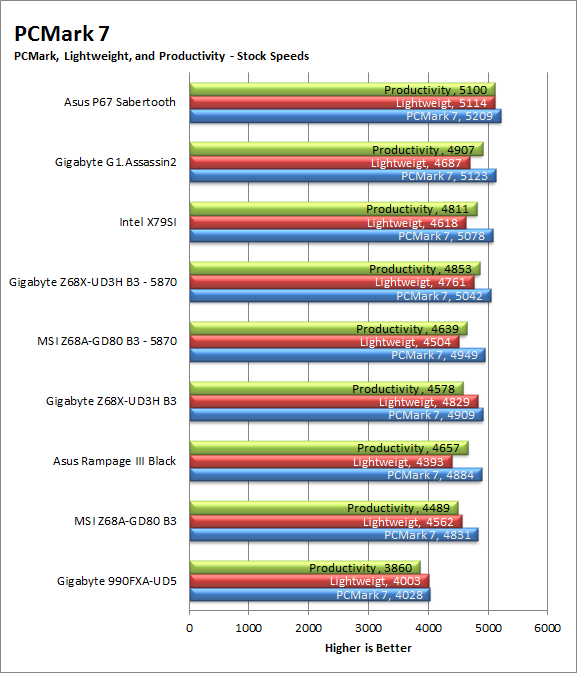
The G1.Assassin2 falls in line just behind the P67 Sabertooth from Asus in our stock PCMark7 run. This is a good indicator that the G1.Assassin2 would be good for most computing tasks. If you were to build this into a single system you would not need to worry if it can handle your spreadsheets or web browsing. 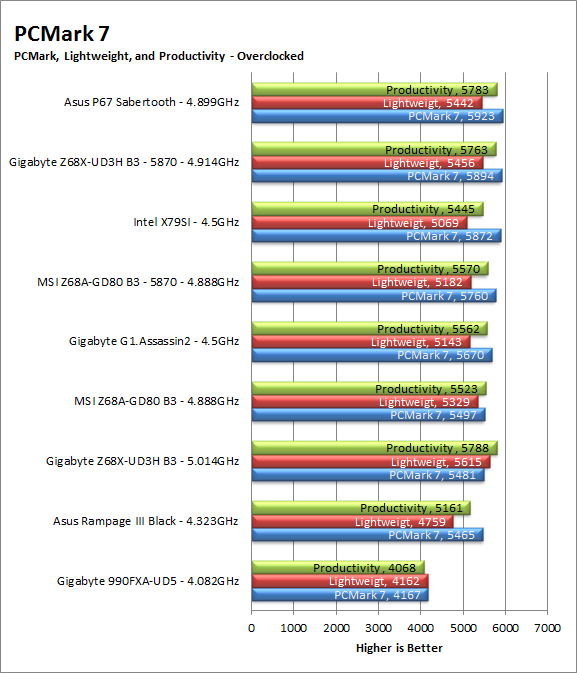
3DMark 11 -
3DMark 11 is the other Futuremark test that we run on our motherboards. This test simulates the typical tasks that a GPU (and system) would have to perform to provide you with a good gaming experience. It is based on the DX9, DX10 and DX11 engines but can only be installed on Windows Vista or later. The suite of tests covers DX9, DX10, and of course DX11 rendering; it also covers AI computations and physics. That’s right I said Physics the latest version of 3DMark uses a Havok physics engine. This removes the advantage that nVidia had with 3DMark Vantage. 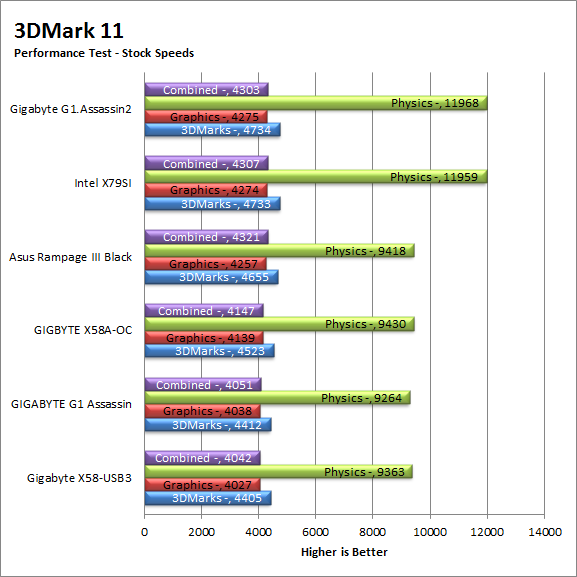
True to its design as a gaming motherboard the G1.Assassin2 gets the top numbers in 3DMark11. The delta between the two top boards is very narrow though. This means that in all honesty you would never know the difference if you had the top two boards playing side by side.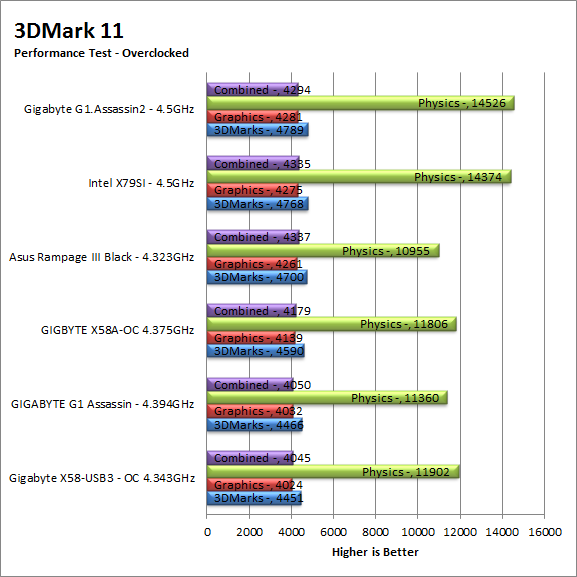
HyperPi 0.99b -
HyperPi is a front end application that allows you to easily run multiple instances of the SuperPi application. SuperPi, for those that are not familiar with it, is an application that measures the time it takes to calculate the number Pi out to as many as 32 million places. This calculation is then checked and run multiple times (up to 24 for a 32M run). This test stresses the CPU, Memory and HDD as data is handed off between the three. If there is a weak link, HyperPi will show it. For our testing we run the 32M test on as many cores (and threads) as the CPU has available. The slowest CPU time is then recorded. 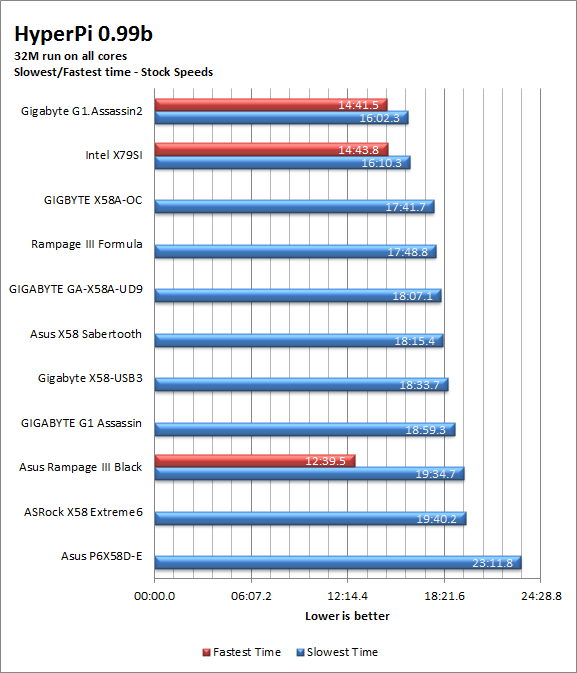
It looks like the extra memory bandwidth really does payoff. The HyperPi times here are very good considering you are running two full 32M SuperPi run on all cores at the same time. This type of memory to CPU to HDD performance can help with everything from office productivity workloads to transcoding your favorit videos. 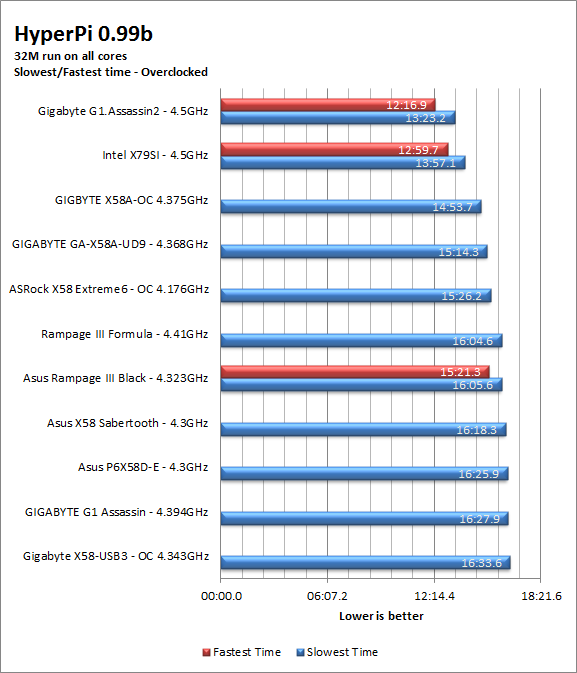
Cinebench R11.5 -
Cinebench R11.5 is the 11th release of Maxon’s rendering test. This test is based off of the Cinema 4D engine, which is one of the industry standard tools for digital animation. It is a powerful product with many different modules that can be “plugged” into it to increase its effectiveness. With Cinebench you get to see how your computer would do using this application. There are two tests; one tests the CPU’s ability to render an image across multiple cores or threads. The other tests your systems ability to handle OpenGL based rendering. 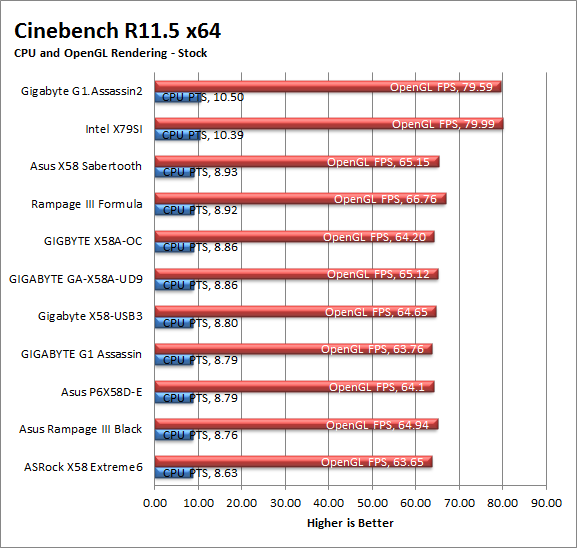
In Cinebench R11.5 the G1.Assassin2 comes out on time again until we overclock it. Despite having the same overclock as the X79SI the Assassin2 comes in right behind (by .01 points) the X79SI. Even this small difference can be huge when you are rendering large scale or multiple frame projects.

 We have now had the G1.Assassin2 up on the test bench for a little over a week now and are ready to talk about our experience with it. The G1.Assassin2 is Gigabyte’s current top of the line x79 motherboard and follows in the same trend as the other boards in the G1 line up. This means that you get the military theme, the built in audio card, and of course the KillerNIC E2100 NPU. However, there are also things that had us concerned about how the G1.Assassin2 might handle certain types of work. So let’s get started and see if all of the new features (like the 3D BIOS and 3D Power) work and if the concerns that we talked about in the
We have now had the G1.Assassin2 up on the test bench for a little over a week now and are ready to talk about our experience with it. The G1.Assassin2 is Gigabyte’s current top of the line x79 motherboard and follows in the same trend as the other boards in the G1 line up. This means that you get the military theme, the built in audio card, and of course the KillerNIC E2100 NPU. However, there are also things that had us concerned about how the G1.Assassin2 might handle certain types of work. So let’s get started and see if all of the new features (like the 3D BIOS and 3D Power) work and if the concerns that we talked about in the 

